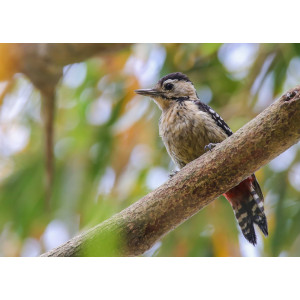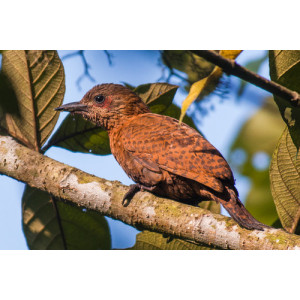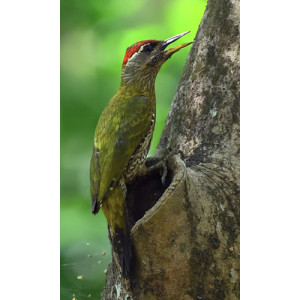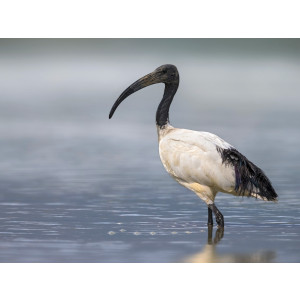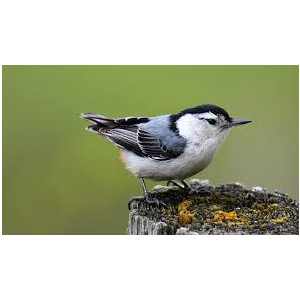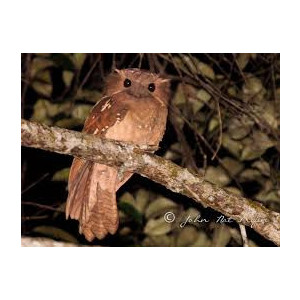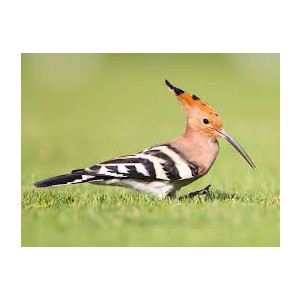Heart‑spotted Woodpecker Did you see this animal?
Scientific Name : Hemicircus canente
Family : Picidae
Order : Piciformes
Class : Aves
Phylum : Chordata
Other Name : Canente Barbet
Habitat : Evergreen forest
Description : The bird in question is a small woodpecker that has a unique shape and coloration. It has a black and buff plumage, with a large crest that makes its head appear larger than its short body and tail. The male and female woodpeckers both have black feathers with heart-shaped black spots on their white shoulders. They also have broad white scapular patches and barring on their flight feathers. However, the female's forehead and crown are buffy white, while the male's are black. The throat is whitish, and the underparts are dark olive grey.
One interesting feature of this woodpecker is a tuft of feathers on its back that is specialized and lipid-rich. This causes the feathers to stick together in preserved specimens, and these feathers are sometimes referred to as "fat quills." The rump feathers may appear buff due to the secretion of these feathers. Although the secretion has a pleasant smell, the functional significance of this "cosmetic coloration" is unknown.
These woodpeckers are known to forage in pairs and occasionally join mixed-species flocks to find food. They travel between trees in a bounding flight that gives them a head-heavy appearance. While foraging, they search for insects under bark on thin branches and frequently communicate with their distinctive calls. Although their diet consists mainly of insects found under tree bark, they have also been observed pecking the pods of Cassia fistula to access insect larvae.
Their calls include a sharp twee-twee-twee, which is often a duet call that may lead to a trill of several notes. They also produce a nasal ki-yeew and repeated su-sie calls. During the breeding season, they drum infrequently, mainly during winter and before the monsoons. The woodpecker's nest is created by boring into a dead branch with a narrow opening of 3 to 4 cm in diameter. The tunnel then goes down obliquely about 20 cm before widening into a chamber. In some cases, they may even build their nests in fence posts. The typical clutch size is 2 or 3 eggs, which are unmarked white
One interesting feature of this woodpecker is a tuft of feathers on its back that is specialized and lipid-rich. This causes the feathers to stick together in preserved specimens, and these feathers are sometimes referred to as "fat quills." The rump feathers may appear buff due to the secretion of these feathers. Although the secretion has a pleasant smell, the functional significance of this "cosmetic coloration" is unknown.
These woodpeckers are known to forage in pairs and occasionally join mixed-species flocks to find food. They travel between trees in a bounding flight that gives them a head-heavy appearance. While foraging, they search for insects under bark on thin branches and frequently communicate with their distinctive calls. Although their diet consists mainly of insects found under tree bark, they have also been observed pecking the pods of Cassia fistula to access insect larvae.
Their calls include a sharp twee-twee-twee, which is often a duet call that may lead to a trill of several notes. They also produce a nasal ki-yeew and repeated su-sie calls. During the breeding season, they drum infrequently, mainly during winter and before the monsoons. The woodpecker's nest is created by boring into a dead branch with a narrow opening of 3 to 4 cm in diameter. The tunnel then goes down obliquely about 20 cm before widening into a chamber. In some cases, they may even build their nests in fence posts. The typical clutch size is 2 or 3 eggs, which are unmarked white
Distribution in Bangladesh
References:
description written by:Hajbun Tasnim Preety,Department of Zoology, University of Dhaka;information source:www.en.wikipedia.org, iucnredlist.org;taxonomic checklist:P. M. Thompson and S. U. Chowdhury (2020). A checklist of birds of Bangladesh.Birds Bangladesh;photo credit: Saurabh Agrawal (www.inaturalist.org/people/Saurabh Agrawal ),photo shared from iNaturalist, photo copyright reserved according to iNaturalist rules;Prateik Kulkarnimore information, please contact us.
description written by:Hajbun Tasnim Preety,Department of Zoology, University of Dhaka;information source:www.en.wikipedia.org, iucnredlist.org;taxonomic checklist:P. M. Thompson and S. U. Chowdhury (2020). A checklist of birds of Bangladesh.Birds Bangladesh;photo credit: Saurabh Agrawal (www.inaturalist.org/people/Saurabh Agrawal ),photo shared from iNaturalist, photo copyright reserved according to iNaturalist rules;Prateik Kulkarnimore information, please contact us.

